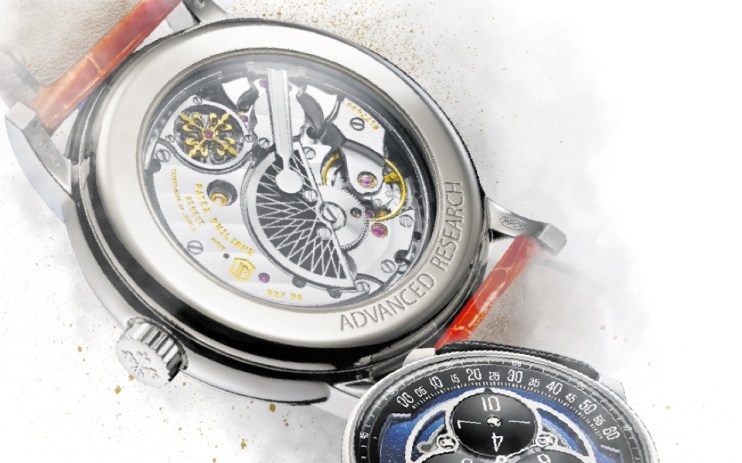Edge of the dial stuff: How Patek Philippe, Audemars et al are making the impossible possible

If Richard Rogers invented ‘techno’ architecture in the seventies, turning buildings like Lloyd’s of London inside-out, then around the same time you can credit Audemars Piguet for inventing ‘techno’ watchmaking. The Swiss marque pioneered the concept of bringing a mechanical timepiece’s inner anatomy dial-side, rendering its ticking works as miniature architecture.
It started with AP’s wafer-thin ‘2870’ tourbillon of 1986, which brought the tumbling, merry-go-round carriage into plain sight, daring to expose the pulsing, pendulous ‘balance’. Running with the fairground analogy, Audemars Piguet’s next adventure in Techno was a teacup ride: the Starwheel of 1991, which was dramatically rebooted earlier this year.
Richard Mille ran with the baton: in 1999 his revolutionary, stripped-back ‘racing machines for the wrist’ showcased all the springs, gears, levers and pinions in glorious 3D, rather than simply ‘skeletonising’ the usual sandwich of bridges that connect them, or cutting a hole in the dial.
It’s an approach that’s become a horological ‘complication’ in its own right. But now Switzerland’s next generation of boffins have been inspired to think *outside* the case…
SATELLITES AND STARS
In Audemars Piguet’s suitably future-forward ’11.59’ construct – a controversial launch back in 2019, with its mesmeric dance of octagons, circles and bizarre ‘floating’ strap attachments – three spinning hour discs whirr on the tips of spinning spokes. Each ‘satellite’ is marked with four hour numerals, taking it in turns to track across a 120º minutes calibration. When it’s time for a disc to begin another arc at ‘0’, as the other reaches ‘60’, a co-axial, four-pronged ‘starwheel’ nudges it round to align the next hour numeral accordingly (you really need to see it in action).
‘Wandering hours’ are by no means new, nor indeed exclusive to AP. The idea was invented in 1656, for the holiest of holy insomniacs, Pope Alexander VII
‘Wandering hours’ are by no means new, nor indeed exclusive to AP. The idea was invented in 1656, for the holiest of holy insomniacs, Pope Alexander VII. It was an internally oil-lit clock readable without the hassle of holding a candle over the dial. In AP’s new limited edition this is reimagined as a shimmering blue aventurine dial. With its three slightly domed discs finished in sandblasted opaline, reading them really is like stargazing into a crisp, miniature night sky.
WRIST ROCKET
Unbelievably, Ulysse Nardin’s Freak continues to spring surprises a full 22 years after its devastating launch. The niche chronometer label’s ‘flying carousel’ sees the entire movement rotate 360 degrees on the face of the dial every 12 hours. It doesn’t stop there: the Freak was a crucible for even wilder innovation, featuring antimagnetic, lubricant-free components laser-etched from silicon wafers.
This year the new Freak S pushes the envelope by including a dual ‘oscillator’ (the circular pendulum whose frantic tick regulates the speed of the gear wheels). It’s UN’s first doubled-up oscillator connected by a differential to average-out and effectively ‘regulate’ the rate of tick, improving both precision and resistance to knocks and wobbles. The silicon has even been coated with a layer of artificial diamond to ease friction. If you’re talking ‘sci-fi’ watchmaking, you won’t find anything like it on the planet, let alone Switzerland.
Montblanc’s Monopusher Chronograph, meanwhile, offers an uninterrupted peep into watchmaking’s most beautiful manually-wound chronographs. Since the historic German penmaker-turned-Swiss watchmaker acquired the historic Minerva factory in 2006, its catalogue of complications has been sympathetically revived.
Mineva’s iconic MB M16.29 calibre has been spun to reveal the lithe curves of its bridges, sinuous stopwatch levers and flawlessly polished bevelled edges – all skeletonised with the delicacy of lacework. Turning a movement over sounds simple, but it is a technical feat given the direction of the hands also needs to be reversed. This limited edition of 88 pieces comes in a 43mm ‘distressed’ stainless steel case with a white gold fluted bezel and features a black nubuck leather strap with ‘distressed’ steel triple-folding clasp.
FF’S ESCAPE
For a grand maison of Patek Philippe’s calibre, producing a chiming, musical ‘minute repeater’ that improved on sound amplification and transmission where most others fail simply goes to show why Geneva’s favourite son continues to sit at the top of tree.
PP is a marque that makes the minute repeater a house speciality, with full mastery of the impossibly tricky task in annealing two circular wire gongs with closely-guarded secret alloy, then ‘tuning’ them to perfect ‘ding’ and ‘dong’ pitch. Plus there’s the constellation of racks, snail cams and star wheels mechanically programmed to translate the current time (down to the second) to the ’strike’ of two tiny hammers upon the gongs.
‘ff’ acts like a mechanical loudspeaker: extending out from in between the gongs to the centre of the movement is what Patek refers to as a ‘sound lever’, attached to a wafer of synthetic sapphire crystal just 0.2mm thick
For its next trick, its crack ‘Advanced Research’ division took the existing in-house R27PS minute repeater movement from 1989 and added a module that they call the ‘ff’ (or ‘fortissimo’ if you know your sheet-music notation). Essentially, ff acts like a mechanical loudspeaker: extending out from in between the gongs to the centre of the movement is what Patek refers to as a ‘sound lever’, attached to a wafer of synthetic sapphire crystal just 0.2mm thick. This tuning-fork-like set-up transmits the sound waves straight through the openings in a titanium movement ring, then through a single minuscule opening between the caseback and band.
But what about dust and splashes? Believe it or not, ingress is prevented by an anti-dust filter; an idea Patek Philippe borrowed from the mobile phone sector. It seems the ff is a particularly smart watch.